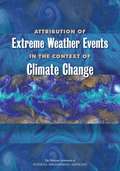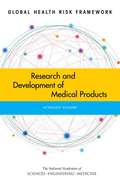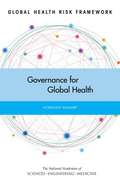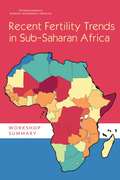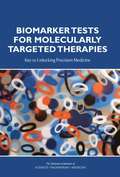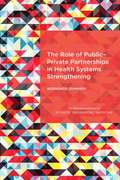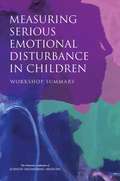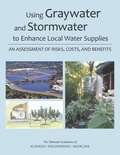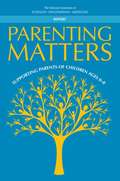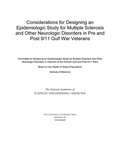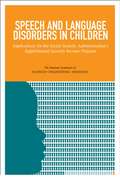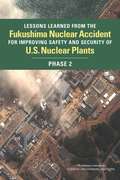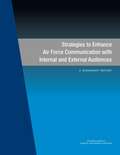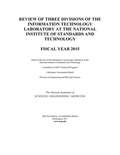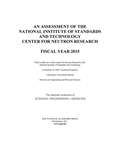- Table View
- List View
Attribution of Extreme Weather Events in the Context of Climate Change
by Engineering Medicine National Academies of SciencesAs climate has warmed over recent years, a new pattern of more frequent and more intense weather events has unfolded across the globe. Climate models simulate such changes in extreme events, and some of the reasons for the changes are well understood. Warming increases the likelihood of extremely hot days and nights, favors increased atmospheric moisture that may result in more frequent heavy rainfall and snowfall, and leads to evaporation that can exacerbate droughts. Even with evidence of these broad trends, scientists cautioned in the past that individual weather events couldn’lt be attributed to climate change. Now, with advances in understanding the climate science behind extreme events and the science of extreme event attribution, such blanket statements may not be accurate. The relatively young science of extreme event attribution seeks to tease out the influence of human-cause climate change from other factors, such as natural sources of variability like El Niño, as contributors to individual extreme events. Event attribution can answer questions about how much climate change influenced the probability or intensity of a specific type of weather event. As event attribution capabilities improve, they could help inform choices about assessing and managing risk, and in guiding climate adaptation strategies. This report examines the current state of science of extreme weather attribution, and identifies ways to move the science forward to improve attribution capabilities.
Global Health Risk Framework: Workshop Summary
by National Academies of Sciences Engineering MedicineSince the 2014 Ebola outbreak many public- and private-sector leaders have seen a need for improved management of global public health emergencies. The effects of the Ebola epidemic go well beyond the three hardest-hit countries and beyond the health sector. Education, child protection, commerce, transportation, and human rights have all suffered. The consequences and lethality of Ebola have increased interest in coordinated global response to infectious threats, many of which could disrupt global health and commerce far more than the recent outbreak. In order to explore the potential for improving international management and response to outbreaks the National Academy of Medicine agreed to manage an international, independent, evidence-based, authoritative, multistakeholder expert commission. As part of this effort, the Institute of Medicine convened four workshops in summer of 2015 to inform the commission report. The presentations and discussions from the Workshop on Research and Development of Medical Products are summarized in this report.
Global Health Risk Framework: Workshop Summary
by Institute of Medicine Alison Mack Forum on Microbial Threats Eileen R. Choffnes Board on Global Health National Academies of Sciences, Engineering, and Medicine Megan R. SnairSince the 2014 Ebola outbreak many public- and private-sector leaders have seen a need for improved management of global public health emergencies. The effects of the Ebola epidemic go well beyond the three hardest-hit countries and beyond the health sector. Education, child protection, commerce, transportation, and human rights have all suffered. The consequences and lethality of Ebola have increased interest in coordinated global response to infectious threats, many of which could disrupt global health and commerce far more than the recent outbreak. In order to explore the potential for improving international management and response to outbreaks the National Academy of Medicine agreed to manage an international, independent, evidence-based, authoritative, multistakeholder expert commission. As part of this effort, the Institute of Medicine convened four workshops in summer of 2015 to inform the commission report. The presentations and discussions from the Governance for Global Health Workshop are summarized in this report.
Global Health Risk Framework: Workshop Summary
by National Academies of Sciences Engineering MedicineSince the 2014 Ebola outbreak many public- and private-sector leaders have seen a need for improved management of global public health emergencies. The effects of the Ebola epidemic go well beyond the three hardest-hit countries and beyond the health sector. Education, child protection, commerce, transportation, and human rights have all suffered. The consequences and lethality of Ebola have increased interest in coordinated global response to infectious threats, many of which could disrupt global health and commerce far more than the recent outbreak. In order to explore the potential for improving international management and response to outbreaks the National Academy of Medicine agreed to manage an international, independent, evidence-based, authoritative, multistakeholder expert commission. As part of this effort, the Institute of Medicine convened four workshops in summer of 2015 to inform the commission report. The presentations and discussions from the Pandemic Financing Workshop are summarized in this report.
Global Health Risk Framework: Workshop Summary
by National Academies of Sciences Engineering MedicineSince the 2014 Ebola outbreak many public- and private-sector leaders have seen a need for improved management of global public health emergencies. The effects of the Ebola epidemic go well beyond the three hardest-hit countries and beyond the health sector. Education, child protection, commerce, transportation, and human rights have all suffered. The consequences and lethality of Ebola have increased interest in coordinated global response to infectious threats, many of which could disrupt global health and commerce far more than the recent outbreak. In order to explore the potential for improving international management and response to outbreaks the National Academy of Medicine agreed to manage an international, independent, evidence-based, authoritative, multistakeholder expert commission. As part of this effort, the Institute of Medicine convened four workshops in summer of 2015 to inform the commission report. The presentations and discussions from the Workshop on Resilient and Sustainable Health Systems to Respond to Global Infectious Disease Outbreaks are summarized in this report.
Recent Fertility Trends in Sub-Saharan Africa: Workshop Summary
by Engineering Medicine National Academies of SciencesFertility rates and population growth influence economic development. The marked declines in fertility seen in some developing nations have been accompanied by slowing population growth, which in turn provided a window of opportunity for rapid economic growth. For many sub-Saharan African nations, this window has not yet opened because fertility rates have not declined as rapidly there as elsewhere. Fertility rates in many sub-Saharan African countries are high: the total rate for the region is estimated to be 5.1 births per woman, and rates that had begun to decline in many countries in the region have stalled. High rates of fertility in these countries are likely to contribute to continued rapid population growth: the United Nations projects that the region's population will increase by 1.2 billion by 2050, the highest growth among the regions for which there are projections. In June 2015, the Committee on Population organized a workshop to explore fertility trends and the factors that have influenced them. The workshop committee was asked to explore history and trends related to fertility, proximate determinants and other influences, the status and impact of family planning programs, and prospects for further reducing fertility rates. This study will help donors, researchers, and policy makers better understand the factors that may explain the slow pace of fertility decline in this region, and develop methods to improve family planning in sub-Saharan Africa.
Accounting for Social Risk Factors in Medicare Payment: Identifying Social Risk Factors
by National Academies of Sciences Engineering MedicineRecent health care payment reforms aim to improve the alignment of Medicare payment strategies with goals to improve the quality of care provided, patient experiences with health care, and health outcomes, while also controlling costs. These efforts move Medicare away from the volume-based payment of traditional fee-for-service models and toward value-based purchasing, in which cost control is an explicit goal in addition to clinical and quality goals. Specific payment strategies include pay-for-performance and other quality incentive programs that tie financial rewards and sanctions to the quality and efficiency of care provided and accountable care organizations in which health care providers are held accountable for both the quality and cost of the care they deliver. Accounting for Social Risk Factors in Medicare Payment: Identifying Social Risk Factors is the first in a series of five reports commissioned to provide input into whether socioeconomic status (SES) and other social risk factors could be accounted for in Medicare payment and quality programs. This report focuses on defining SES and other social factors for the purposes of application to Medicare quality measurement and payment programs.
Appropriate Use of Advanced Technologies for Radiation Therapy and Surgery in Oncology: Workshop Summary
by National Academies of Sciences Engineering MedicineIn recent years, the field of oncology has witnessed a number of technological advances, including more precise radiation therapy and minimally invasive surgical techniques. Three-dimensional (3D), stereotactic, and proton-beam radiation therapy, as well as laparoscopy and robotic surgery, can enhance clinician's ability to treat conditions that were clinically challenging with conventional technologies, and may improve clinical outcomes or reduce treatment-related problems for some patients. Both patients and physicians seek access to these new technologies, which are rapidly being adopted into standard clinical practice. Such demand is often propelled by marketing that portrays the new technologies as the “latest and greatest” treatments available. However, evidence is often lacking to support these claims, and these novel technologies usually come with higher price tags and are often used to treat patients who might have achieved similar benefits from less expensive, conventional treatment. The increased cost of novel treatments without adequate assessment of how they affect patient outcomes is a pressing concern given that inappropriate use of expensive technologies is one of the key factors that threaten the affordability of cancer care in the United States. To explore these issues further, the National Cancer Policy Forum (NCPF) of the Institute of Medicine organized a workshop in July 2015. This is the third NCPF workshop in a series examining the affordability of cancer care. Participants explored clinical benefits and comparative effectiveness of emerging advanced technologies for cancer treatment in radiation therapy and surgery and potential strategies to assess the value and promote optimal use of new technologies in cancer treatment. This report summarizes the presentations and discussions from the workshop.
Biomarker Tests for Molecularly Targeted Therapies: Key to Unlocking Precision Medicine
by National Academies of Sciences Engineering MedicineEvery patient is unique, and the evolving field of precision medicine aims to ensure the delivery of the right treatment to the right patient at the right time. In an era of rapid advances in biomedicine and enhanced understanding of the genetic basis of disease, health care providers increasingly have access to advanced technologies that may identify molecular variations specific to an individual patient, which subsequently can be targeted for treatment. Known as biomarker tests for molecularly targeted therapies, these complex tests have the potential to enable the selection of the most beneficial treatment (and also to identify treatments that may be harmful or ineffective) for the molecular underpinnings of an individual patient’s disease. Such tests are key to unlocking the promise of precision medicine. Biomarker tests for molecularly targeted therapies represent a crucial area of focus for developing methods that could later be applicable to other areas of precision medicine. The appropriate regulatory oversight of these tests is required to ensure that they are accurate, reliable, properly validated, and appropriately implemented in clinical practice. Moreover, common evidentiary standards for assessing the beneficial impact of biomarker-guided therapy selection on patient outcomes, as well as the effective collection and sharing of information related to those outcomes, are urgently needed to better inform clinical decision making. Biomarker Tests of Molecularly Targeted Therapies examines opportunities for and challenges to the use of biomarker tests to select optimal therapy and offers recommendations to accelerate progress in this field. This report explores regulatory issues, reimbursement issues, and clinical practice issues related to the clinical development and use of biomarker tests for targeting therapies to patients. Properly validated, appropriately implemented biomarker tests hold the potential to enhance patient care and improve outcomes, and therefore addressing the challenges facing such tests is critical.
The Role of Public-Private Partnerships in Health Systems Strengthening: Workshop Summary
by National Academies of Sciences Engineering MedicineOver the past several decades, the public and private sectors made significant investments in global health, leading to meaningful changes for many of the world's poor. These investments and the resulting progress are often concentrated in vertical health programs, such as child and maternal health, malaria, and HIV, where donors may have a strategic interest. Frequently, partnerships between donors and other stakeholders can coalesce on a specific topical area of expertise and interest. However, to sustain these successes and continue progress, there is a growing recognition of the need to strengthen health systems more broadly and build functional administrative and technical infrastructure that can support health services for all, improve the health of populations, increase the purchasing and earning power of consumers and workers, and advance global security. In June 2015, the National Academies of Sciences, Engineering, and Medicine held a workshop on the role of public-private partnerships (PPPs) in health systems strengthening. Participants examined a range of incentives, innovations, and opportunities for relevant sectors and stakeholders in strengthening health systems through partnerships; to explore lessons learned from pervious and ongoing efforts with the goal of illuminating how to improve performance and outcomes going forward; and to discuss measuring the value and outcomes of investments and documenting success in partnerships focused on health systems strengthening. This report summarizes the presentations and discussions from the workshop.
Measuring Serious Emotional Disturbance in Children: Workshop Summary
by National Academies of Sciences, Engineering, and Medicine Institute of Medicine Board on Health Sciences Policy Division of Behavioral and Social Sciences and Education Board on Behavioral, Cognitive, and Sensory Sciences Committee on National StatisticsThe workshop summarized in this report was organized as part of a study sponsored by the Substance Abuse and Mental Health Services Administration (SAMHSA) and the Office of the Assistant Secretary for Planning and Evaluation of the U.S. Department of Health and Human Services, with the goal of assisting SAMHSA in its responsibilities of expanding the collection of behavioral health data in several areas. The workshop brought together experts in child mental health, psychiatric epidemiology and survey methods to facilitate discussion of the most suitable measures and mechanisms for producing estimates of serious emotional disturbance in children, which are necessary to enable the distribution of block grants that support state-level mental health services for children. The report discusses existing measures and data on mental disorders and functional impairment, challenges associated with collecting these data in large-scale population-based studies, as well as study design and estimation options.
Using Graywater and Stormwater to Enhance Local Water Supplies: An Assessment of Risks, Costs, and Benefits
by National Academies of Sciences Engineering MedicineChronic and episodic water shortages are becoming common in many regions of the United States, and population growth in water-scarce regions further compounds the challenges. Increasingly, alternative water sources such as graywater-untreated wastewater that does not include water from the toilet but generally includes water from bathroom sinks, showers, bathtubs, clothes washers, and laundry sinks- and stormwater-water from rainfall or snow that can be measured downstream in a pipe, culvert, or stream shortly after the precipitation event-are being viewed as resources to supplement scarce water supplies rather than as waste to be discharged as rapidly as possible. Graywater and stormwater can serve a range of non-potable uses, including irrigation, toilet flushing, washing, and cooling, although treatment may be needed. Stormwater may also be used to recharge groundwater, which may ultimately be tapped for potable use. In addition to providing additional sources of local water supply, harvesting stormwater has many potential benefits, including energy savings, pollution prevention, and reducing the impacts of urban development on urban streams. Similarly, the reuse of graywater can enhance water supply reliability and extend the capacity of existing wastewater systems in growing cities. Despite the benefits of using local alternative water sources to address water demands, many questions remain that have limited the broader application of graywater and stormwater capture and use. In particular, limited information is available on the costs, benefits, and risks of these projects, and beyond the simplest applications many state and local public health agencies have not developed regulatory frameworks for full use of these local water resources. To address these issues, Using Graywater and Stormwater to Enhance Local Water Supplies analyzes the risks, costs, and benefits on various uses of graywater and stormwater. This report examines technical, economic, regulatory, and social issues associated with graywater and stormwater capture for a range of uses, including non-potable urban uses, irrigation, and groundwater recharge. Using Graywater and Stormwater to Enhance Local Water Supplies considers the quality and suitability of water for reuse, treatment and storage technologies, and human health and environmental risks of water reuse. The findings and recommendations of this report will be valuable for water managers, citizens of states under a current drought, and local and state health and environmental agencies.
Telecommunications Research and Engineering at the Institute for Telecommunication Sciences of the Department of Commerce: Meeting the Nation's Telecommunications Needs
by Committee on Telecommunications Research Engineering at the Department of Commerce's Boulder LaboratoriesThe Department of Commerce operates two telecommunications research laboratories located at the Department of Commerce's Boulder, Colorado, campus: the National Telecommunications and Information Administration's (NTIA's) Institute for Telecommunications Sciences (ITS) and the National Institute of Standards and Technology's (NIST's) Communications Technology Laboratory (CTL). ITS serves as a principal federal resource for solving the telecommunications concerns of federal agencies, state and local governments, private corporations and associations, standards bodies, and international organizations. ITS could provide an essential service to the nation by being a principal provider of instrumentation and spectrum measurement services; however, the inter-related shortages of funding, staff, and a coherent strategy limits its ability to fully function as a research laboratory. This report examines the institute's performance, resources, and capabilities and the extent to which these meet customer needs. The Boulder telecommunications laboratories currently play an important role in the economic vitality of the country and can play an even greater role given the importance of access to spectrum and spectrum sharing to the wireless networking and mobile cellular industries. Research advances are needed to ensure the continued evolution and enhancement of the connected world the public has come to expect.
Parenting Matters: Supporting Parents of Children Ages 0-8
by National Academies of Sciences Engineering MedicineDecades of research have demonstrated that the parent-child dyad and the environment of the family—which includes all primary caregivers—are at the foundation of children’s well- being and healthy development. From birth, children are learning and rely on parents and the other caregivers in their lives to protect and care for them. The impact of parents may never be greater than during the earliest years of life, when a child’s brain is rapidly developing and when nearly all of her or his experiences are created and shaped by parents and the family environment. Parents help children build and refine their knowledge and skills, charting a trajectory for their health and well-being during childhood and beyond. The experience of parenting also impacts parents themselves. For instance, parenting can enrich and give focus to parents’ lives; generate stress or calm; and create any number of emotions, including feelings of happiness, sadness, fulfillment, and anger. Parenting of young children today takes place in the context of significant ongoing developments. These include: a rapidly growing body of science on early childhood, increases in funding for programs and services for families, changing demographics of the U.S. population, and greater diversity of family structure. Additionally, parenting is increasingly being shaped by technology and increased access to information about parenting. Parenting Matters identifies parenting knowledge, attitudes, and practices associated with positive developmental outcomes in children ages 0-8; universal/preventive and targeted strategies used in a variety of settings that have been effective with parents of young children and that support the identified knowledge, attitudes, and practices; and barriers to and facilitators for parents’ use of practices that lead to healthy child outcomes as well as their participation in effective programs and services. This report makes recommendations directed at an array of stakeholders, for promoting the wide-scale adoption of effective programs and services for parents and on areas that warrant further research to inform policy and practice. It is meant to serve as a roadmap for the future of parenting policy, research, and practice in the United States.
A Satellite Account to Measure the Retail Transformation: Organizational, Conceptual, And Data Foundations
by National Academies of Sciences, Engineering, and Medicine Division of Behavioral and Social Sciences and Education Committee on National Statistics Panel on Measuring the Transformation of Retail Trade and Related ActivitiesRetail trade has experienced dramatic changes over the past several decades in the United States, with changes in the types of outlets where goods are sold, the nature of the transactions that provide goods to consumers, and the structure of retail operations behind the scenes. The recent changes include the rise of warehouse stores and e-commerce and the further growth of imports and large retail chains. These changes highlight and typify many aspects of the broader evolution of the economy as a whole in recent years - with the growing role of large firms and information technology - while taking place in a sector that directly serves the vast majority of the American population and provides substantial employment. Despite the everyday experience of these dramatic changes in retail, there is concern that the most transformational aspects of those changes may not be captured well by the economic indicators about the sector. In order to develop appropriate economic policies, we need to be able to capture more detailed data, including data about changes to productivity. At the request of the U.S. Bureau of Labor Statistics, this report evaluates changes in the retail trade sector, assesses measures of employment and labor productivity for the sector, and recommends a new satellite account that could measure retail-related employment and labor productivity in ways that would better capture the transformation.
Considerations for Designing an Epidemiologic Study for Multiple Sclerosis and Other Neurologic Disorders in Pre and Post 9/11 Gulf War Veterans
by Committee on Designing Epidemiologic Study for Multiple Sclerosis Other Neurologic Disorders in Veterans of the Persian Gulf Post 9/11 WarsConsiderations for Designing an Epidemiologic Study for Multiple Sclerosis and Other Neurologic Disorders in Pre and Post 9/11 Gulf War Veterans
Mitochondrial Replacement Techniques: Ethical, Social, and Policy Considerations
by National Academies of Sciences Engineering MedicineMitochondrial replacement techniques (MRTs) are designed to prevent the transmission of mitochondrial DNA (mtDNA) diseases from mother to child. While MRTs, if effective, could satisfy a desire of women seeking to have a genetically related child without the risk of passing on mtDNA disease, the technique raises significant ethical and social issues. It would create offspring who have genetic material from two women, something never sanctioned in humans, and would create mitochondrial changes that could be heritable (in female offspring), and therefore passed on in perpetuity. The manipulation would be performed on eggs or embryos, would affect every cell of the resulting individual, and once carried out this genetic manipulation is not reversible. Mitochondrial Replacement Techniques considers the implications of manipulating mitochondrial content both in children born to women as a result of participating in these studies and in descendants of any female offspring. This study examines the ethical and social issues related to MRTs, outlines principles that would provide a framework and foundation for oversight of MRTs, and develops recommendations to inform the Food and Drug Administration’s consideration of investigational new drug applications.
Speech and Language Disorders in Children: Implications for the Social Security Administration’s Supplemental Security Income Program
by National Academies of Sciences Engineering MedicineSpeech and language are central to the human experience; they are the vital means by which people convey and receive knowledge, thoughts, feelings, and other internal experiences. Acquisition of communication skills begins early in childhood and is foundational to the ability to gain access to culturally transmitted knowledge, organize and share thoughts and feelings, and participate in social interactions and relationships. Thus, speech disorders and language disorders--disruptions in communication development--can have wide-ranging and adverse impacts on the ability to communicate and also to acquire new knowledge and fully participate in society. Severe disruptions in speech or language acquisition have both direct and indirect consequences for child and adolescent development, not only in communication, but also in associated abilities such as reading and academic achievement that depend on speech and language skills. The Supplemental Security Income (SSI) program for children provides financial assistance to children from low-income, resource-limited families who are determined to have conditions that meet the disability standard required under law. Between 2000 and 2010, there was an unprecedented rise in the number of applications and the number of children found to meet the disability criteria. The factors that contribute to these changes are a primary focus of this report. Speech and Language Disorders in Children provides an overview of the current status of the diagnosis and treatment of speech and language disorders and levels of impairment in the U.S. population under age 18. This study identifies past and current trends in the prevalence and persistence of speech disorders and language disorders for the general U.S. population under age 18 and compares those trends to trends in the SSI childhood disability population.
Next Generation Earth System Prediction: Strategies for Subseasonal to Seasonal Forecasts
by National Academies of Sciences Engineering MedicineAs the nation’s economic activities, security concerns, and stewardship of natural resources become increasingly complex and globally interrelated, they become ever more sensitive to adverse impacts from weather, climate, and other natural phenomena. For several decades, forecasts with lead times of a few days for weather and other environmental phenomena have yielded valuable information to improve decision-making across all sectors of society. Developing the capability to forecast environmental conditions and disruptive events several weeks and months in advance could dramatically increase the value and benefit of environmental predictions, saving lives, protecting property, increasing economic vitality, protecting the environment, and informing policy choices. Over the past decade, the ability to forecast weather and climate conditions on subseasonal to seasonal (S2S) timescales, i.e., two to fifty-two weeks in advance, has improved substantially. Although significant progress has been made, much work remains to make S2S predictions skillful enough, as well as optimally tailored and communicated, to enable widespread use. Next Generation Earth System Predictions presents a ten-year U.S. research agenda that increases the nation’s S2S research and modeling capability, advances S2S forecasting, and aids in decision making at medium and extended lead times.
Lessons Learned from the Fukushima Nuclear Accident for Improving Safety and Security of U.S. Nuclear Plants: Phase 2
by National Academies of Sciences Engineering MedicineThe U.S. Congress asked the National Academy of Sciences to conduct a technical study on lessons learned from the Fukushima Daiichi nuclear accident for improving safety and security of commercial nuclear power plants in the United States. This study was carried out in two phases: Phase 1, issued in 2014, focused on the causes of the Fukushima Daiichi accident and safety-related lessons learned for improving nuclear plant systems, operations, and regulations exclusive of spent fuel storage. This Phase 2 report focuses on three issues: (1) lessons learned from the accident for nuclear plant security, (2) lessons learned for spent fuel storage, and (3) reevaluation of conclusions from previous Academies studies on spent fuel storage.
Between Public and Private Mobility: Examining the Rise of Technology-Enabled Transportation Services
by National Academies of Sciences Engineering MedicineTRB Special Report 319: Between Public and Private Mobility: Examining the Rise of Technology-Enabled Transportation Services analyzes how innovative transportation services, including ridesharing, carsharing, bikesharing, and microtransit, are changing mobility for millions of travelers. Such services could reduce congestion and emissions from surface transportation if regulated wisely to encourage concurrent, rather than sequential, ride sharing. Rapidly growing transportation network companies (TNCs), like Uber and Lyft, however, are disrupting conventional taxi and limousine services and raise policy challenges regarding personal security and public safety, insurance requirements, employment and labor issues, and accessibility and equity. The committee’s report offers guidance to state and local officials responsible for policy setting and regulation of for-hire transportation services in each of these areas. The report also addresses the need for greater consistency in regulations across jurisdictions and calls for TNCs to share more information about the volume, frequency, and types of trips being provided to allow for informed regulation and planning of transportation services. Report appendixes are available online only: • Appendix A: Taxonomy of Established and Emerging Personal Transportation Services •Appendix B: Taxi, Sedan, and Limousine Industries and Regulations, by Bruce Schaller •Appendix C: Bikesharing Safety and Helmet Use Supplemental information includes a press release, a recorded webcast taped on January 13, 2016 at the TRB Annual Meeting, a Report in Brief, and 10 Facts about Using Uber, Lyft, or Taxis.
Strategies to Enhance Air Force Communication with Internal and External Audiences: A Workshop Report
by Division on Engineering and Physical Sciences Air Force Studies Board National Academies of Sciences, Engineering, and Medicine Committee on Strategies to Enhance Air Force Communication with Internal and External Audiences: A WorkshopThe U.S. Air Force (USAF) helps defend the United States and its interests by organizing, training, and equipping forces for operations in and through three distinct domains -- air, space, and cyberspace. The Air Force concisely expresses its vision as "Global Vigilance, Global Reach, and Global Power for America." Operations within each of these domains are dynamic, take place over large distances, occur over different operational timelines, and cannot be routinely seen or recorded, making it difficult for Airmen, national decision makers, and the American People to visualize and comprehend the full scope of Air Force operations. As a result, the Air Force faces increasing difficulty in succinctly and effectively communicating the complexity, dynamic range, and strategic importance of its mission to Airmen and to the American people. To address this concern, the Chief of Staff of the USAF requested that the National Academies of Sciences, Engineering, and Medicine convene a workshop to explore options on how the Air Force can effectively communicate the strategic importance of the Service, its mission, and the role it plays in the defense of the United States. Participants worked to address the issues that a diverse workforce encompassing a myriad of backgrounds, education, and increasingly diverse current mission sets drives the requirement for a new communication strategy. The demographics of today's Air Force creates both a unique opportunity and a distinct challenge to Air Force leadership as it struggles to communicate its vision and strategy effectively across several micro-cultures within the organization and to the general public. This report summarizes the presentations and discussions from the workshop.
Review of Three Divisions of the Information Technology Laboratory at the National Institute of Standards and Technology: Fiscal Year 2015
by Panel on Review of the Information Technology Laboratory at the National Institute of Standards TechnologyAt the request of the National Institute of Standards and Technology (NIST), the National Academies of Sciences, Engineering, and Medicine has, since 1959, annually assembled panels of experts from academia, industry, medicine, and other scientific and engineering environments to assess the quality and effectiveness of the NIST measurements and standards laboratories, of which there are now seven, as well as the adequacy of the laboratories' resources. Review of Three Divisions of the Information Technology Laboratory at the National Institute of Standards and Technology: Fiscal Year 2015 assesses the organization's technical programs, the portfolio of scientific expertise within the organization, the adequacy of the organization's facilities, equipment, and human resources, and the effectiveness by which the organization disseminates its program outputs.
An Assessment of the National Institute of Standards and Technology Center for Neutron Research: Fiscal Year 2015
by Panel on Review of the Center for Neutron Research at the National Institute of Standards TechnologyAt the request of the National Institute of Standards and Technology (NIST), the National Academies of Sciences, Engineering, and Medicine has, since 1959 annually assembled panels of experts from academia, industry, medicine, and other scientific and engineering environments to assess the quality and effectiveness of the NIST measurements and standards laboratories, of which there are now seven, as well as the adequacy of the laboratories’ resources. An Assessment of the National Institute of Standards and Technology Center for Neutron Research: Fiscal Year 2015 reviews the organization's technical programs, the portfolio of scientific expertise within the organization, the adequacy of the organization's facilities, equipment, and human resources, and the effectiveness with which the organization disseminates its program outputs.
Privacy Research and Best Practices: Summary of a Workshop for the Intelligence Community
by Computer Science and Telecommunications Board Division on Engineering and Physical Sciences National Academies of Sciences, Engineering, and Medicine Emily Grumbling Committee for a Workshop on Privacy for the Intelligence Community: Emerging Technologies, Academic and Industry Research, and Best PracticesRecent disclosures about the bulk collection of domestic phone call records and other signals intelligence programs have stimulated widespread debate about the implications of such practices for the civil liberties and privacy of Americans. In the wake of these disclosures, many have identified a need for the intelligence community to engage more deeply with outside privacy experts and stakeholders. At the request of the Office of the Director of National Intelligence, the National Academies of Sciences, Engineering, and Medicine convened a workshop to address the privacy implications of emerging technologies, public and individual preferences and attitudes toward privacy, and ethical approaches to data collection and use. This report summarizes discussions between experts from academia and the private sector and from the intelligence community on private sector best practices and privacy research results.
